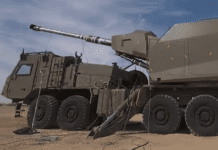
This post is also available in:
 עברית (Hebrew)
עברית (Hebrew)
Many factors make autonomous underwater systems tricky to put into practice. Water clarity can range from glass-clear to extremely turbid, with visibility sometimes in the inches. GPS and other navigational aids are often severely degraded or unavailable underwater.
The U.S. military has a long history of working on the seafloor, including tapping Soviet communications cables during the Cold War, raising sunken submarines, recovering crashed aircraft, placing sea mines, and other tasks — many sensitive or even secret.
The Defense Advanced Research Projects Agency (DARPA) has recently announced it was interested in the development of a new autonomous underwater drone that can manipulate objects on the seabed floor, all without input from a human operator. The so-called “Angler” drone could be useful for all sorts of tasks, from tapping underwater communications cables to salvaging missile debris.
DARPA’s notice says the agency is looking for “an autonomous undersea robot capable of transiting large distances and physically manipulating objects on the seabed with no communications or human intervention.”
The solicitation says the robotic system will operate using an onboard sensor suite to self-localize, avoid obstacles, manage interaction with the seabed environment, and fulfill manipulation mission objectives. In addition to these navigation and positioning challenges, the robot will be able to perform these search and manipulation objectives autonomously, even in dark, turbulent, and semi-opaque sea conditions.
According to popularmechanics.com, the Angler drone will travel closer to the seafloor than aerial drones travel to the ground, making navigation much more hazardous.
The potential is widespread. A drone like Angler could be sent to the ocean floor to pick up missile debris off the coast of North Korea, giving intelligence analysts a glimpse into the design, construction, and materials used in the missile. A drone could even help locate and identify or salvage crashed airplanes and ships.

























